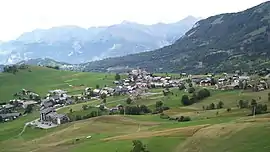Albiez-Montrond
Albiez-Montrond is a commune in the Savoie department in the Auvergne-Rhône-Alpes region in south-eastern France.
Albiez-Montrond | |
|---|---|
 A general view of Albiez-Montrond | |
Location of Albiez-Montrond | |
 Albiez-Montrond  Albiez-Montrond | |
| Coordinates: 45°13′14″N 6°20′29″E | |
| Country | France |
| Region | Auvergne-Rhône-Alpes |
| Department | Savoie |
| Arrondissement | Saint-Jean-de-Maurienne |
| Canton | Saint-Jean-de-Maurienne |
| Intercommunality | Cœur de Maurienne Arvan |
| Government | |
| • Mayor (2020–2026) | Jean Didier[1] |
| Area 1 | 48.58 km2 (18.76 sq mi) |
| Population | 364 |
| • Density | 7.5/km2 (19/sq mi) |
| Time zone | UTC+01:00 (CET) |
| • Summer (DST) | UTC+02:00 (CEST) |
| INSEE/Postal code | 73013 /73300 |
| Elevation | 738–3,320 m (2,421–10,892 ft) |
| 1 French Land Register data, which excludes lakes, ponds, glaciers > 1 km2 (0.386 sq mi or 247 acres) and river estuaries. | |
Geography
Climate
Albiez-Montrond has a humid continental climate (Köppen climate classification Dfb). The average annual temperature in Albiez-Montrond is 6.6 °C (43.9 °F). The average annual rainfall is 955.9 mm (37.63 in) with November as the wettest month. The temperatures are highest on average in July, at around 14.9 °C (58.8 °F), and lowest in January, at around −1.0 °C (30.2 °F). The highest temperature ever recorded in Albiez-Montrond was 32.1 °C (89.8 °F) on 7 July 2015; the coldest temperature ever recorded was −22.6 °C (−8.7 °F) on 5 February 2012.
| Climate data for Albiez-Montrond (1991−2020 normals, extremes 1992−present) | |||||||||||||
|---|---|---|---|---|---|---|---|---|---|---|---|---|---|
| Month | Jan | Feb | Mar | Apr | May | Jun | Jul | Aug | Sep | Oct | Nov | Dec | Year |
| Record high °C (°F) | 13.8 (56.8) |
16.9 (62.4) |
18.7 (65.7) |
21.5 (70.7) |
26.8 (80.2) |
31.0 (87.8) |
32.1 (89.8) |
30.1 (86.2) |
24.6 (76.3) |
25.3 (77.5) |
20.0 (68.0) |
16.0 (60.8) |
32.1 (89.8) |
| Average high °C (°F) | 3.1 (37.6) |
4.0 (39.2) |
7.4 (45.3) |
10.1 (50.2) |
14.0 (57.2) |
17.9 (64.2) |
20.2 (68.4) |
19.7 (67.5) |
15.4 (59.7) |
12.1 (53.8) |
6.8 (44.2) |
3.5 (38.3) |
11.2 (52.2) |
| Daily mean °C (°F) | −1.0 (30.2) |
−0.7 (30.7) |
2.4 (36.3) |
5.4 (41.7) |
9.3 (48.7) |
12.8 (55.0) |
14.9 (58.8) |
14.8 (58.6) |
11.0 (51.8) |
7.8 (46.0) |
2.8 (37.0) |
−0.3 (31.5) |
6.6 (43.9) |
| Average low °C (°F) | −5.1 (22.8) |
−5.4 (22.3) |
−2.6 (27.3) |
0.8 (33.4) |
4.6 (40.3) |
7.7 (45.9) |
9.6 (49.3) |
9.9 (49.8) |
6.5 (43.7) |
3.5 (38.3) |
−1.1 (30.0) |
−4.0 (24.8) |
2.0 (35.6) |
| Record low °C (°F) | −19.2 (−2.6) |
−22.6 (−8.7) |
−17.9 (−0.2) |
−11.2 (11.8) |
−5.4 (22.3) |
−3.5 (25.7) |
0.5 (32.9) |
0.1 (32.2) |
−5.0 (23.0) |
−9.8 (14.4) |
−14.6 (5.7) |
−17.5 (0.5) |
−22.6 (−8.7) |
| Average precipitation mm (inches) | 85.5 (3.37) |
66.1 (2.60) |
69.3 (2.73) |
71.3 (2.81) |
91.2 (3.59) |
76.1 (3.00) |
72.1 (2.84) |
77.3 (3.04) |
73.3 (2.89) |
81.3 (3.20) |
97.1 (3.82) |
95.3 (3.75) |
955.9 (37.63) |
| Average precipitation days (≥ 1.0 mm) | 9.9 | 8.4 | 9.0 | 9.6 | 11.6 | 10.5 | 8.5 | 9.2 | 7.9 | 9.3 | 9.9 | 10.6 | 114.1 |
| Source: Météo-France[3] | |||||||||||||
Population
| Year | Pop. | ±% p.a. |
|---|---|---|
| 1968 | 376 | — |
| 1975 | 349 | −1.06% |
| 1982 | 319 | −1.28% |
| 1990 | 301 | −0.72% |
| 1999 | 382 | +2.68% |
| 2007 | 362 | −0.67% |
| 2012 | 382 | +1.08% |
| 2017 | 376 | −0.32% |
| Source: INSEE[4] | ||
See also
References
- "Répertoire national des élus: les maires". data.gouv.fr, Plateforme ouverte des données publiques françaises (in French). 2 December 2020.
- "Populations légales 2020". The National Institute of Statistics and Economic Studies. 29 December 2022.
- "Fiche Climatologique Statistiques 1991-2020 et records" (PDF) (in French). Météo-France. Retrieved September 4, 2022.
- Population en historique depuis 1968, INSEE
Wikimedia Commons has media related to Albiez-Montrond.
This article is issued from Wikipedia. The text is licensed under Creative Commons - Attribution - Sharealike. Additional terms may apply for the media files.